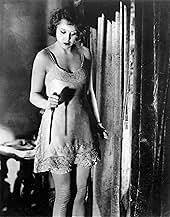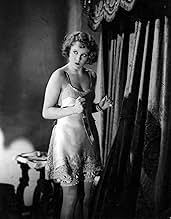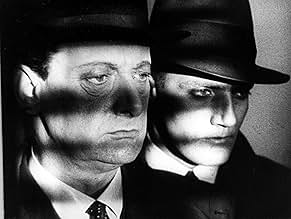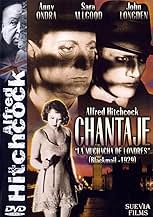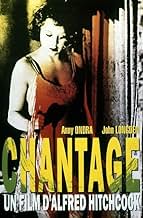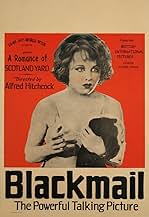IMDb-BEWERTUNG
6,9/10
13.016
IHRE BEWERTUNG
Nachdem sie einen Mann in Notwehr getötet hat, wird eine junge Frau von einem Zeugen erpresst.Nachdem sie einen Mann in Notwehr getötet hat, wird eine junge Frau von einem Zeugen erpresst.Nachdem sie einen Mann in Notwehr getötet hat, wird eine junge Frau von einem Zeugen erpresst.
- Auszeichnungen
- 2 wins total
Ex-Det. Sergt. Bishop
- The Detective Sergeant
- (as Ex-Det. Sergt. Bishop - Late C.I.D. Scotland Yard)
Johnny Ashby
- Boy
- (Nicht genannt)
Joan Barry
- Alice White
- (Synchronisation)
- (Nicht genannt)
Johnny Butt
- Sergeant
- (Nicht genannt)
Alfred Hitchcock
- Man on Subway
- (Nicht genannt)
Phyllis Konstam
- Gossiping Neighbour
- (Nicht genannt)
Sam Livesey
- The Chief Inspector (silent version)
- (Nicht genannt)
Phyllis Monkman
- Gossip Woman
- (Nicht genannt)
Percy Parsons
- Crook
- (Nicht genannt)
Empfohlene Bewertungen
A common motif in Alfred Hitchcock's movies is the guilty woman: "Blackmail", "Psycho" and "The Birds" are all prime examples. In "Blackmail", Alice White (Anny Ondra) goes home with an artist one night and he tries to rape her. She murders him, and from then on everything reminds her of it. The jester painting appears to be looking at her (or she at it?), a billboard looks like a knife, and a woman keeps uttering the word knife. But in the end, everything blows up in Alice's face.
Hitch was certainly showing his chops here. The camera angles, scenery, and other such things all combined to make what we would expect in a Hitchcock movie. I try to imagine being a moviegoer in 1929 watching "Blackmail" for the first time, wondering what Hitchcock's subsequent work would be like.
Hitch was certainly showing his chops here. The camera angles, scenery, and other such things all combined to make what we would expect in a Hitchcock movie. I try to imagine being a moviegoer in 1929 watching "Blackmail" for the first time, wondering what Hitchcock's subsequent work would be like.
While remembered as the first sound picture made by Alfred Hitchcock (or anyone else in Britain), there is much more to "Blackmail" than merely historical interest. It reveals the director's subtle creativity, with a carefully structured story that also produces some real suspense, with one of Hitchcock's best cameos and an entertaining chase sequence as bonuses. The movie has a unique feel, as Hitchcock was still using many silent film techniques at the same time that he was experimenting with sound. Not all of this works perfectly, but it does not detract from the film's many positive features.
Alice White (Anny Ondra, voice dubbed by Joan Barry) goes out for the evening with her boyfriend, who is a police detective (John Longden). When they have a series of minor quarrels, Alice decides to go her own way, and meets an artist friend. The artist's intentions are obvious, but Alice is innocently unaware. When he brings her to his studio, there is soon an unpleasant confrontation that sets in motion a turbulent series of events.
The story is carefully constructed not just to produce suspense but also to raise interesting questions in the viewer's mind. Alice feels a terrible sense of guilt and fear over what has happened - communicated to the viewer in a variety of creative ways - but of what is she really guilty? The behavior of the detective boyfriend is partly well-intentioned, but he certainly is not faultless. The moral ambiguity is often subtle, because it takes a back seat to the suspense, and it takes a couple of viewings to appreciate all that is going on.
There is a particularly nice symmetry to the beginning and ending, pointing to the greater significance of the action in between. The opening sequence (filmed in silent movie style) shows the detective and his partner dealing with a suspect in a routine way, not caring about him as a person. In the final scenes, when the detective must help Alice make a final report on everything that has happened, he sees his job in a far different perspective.
"Blackmail" is of the darker type of Hitchcock, like "Notorious" or "Vertigo". While clearly made in a different era, it has the same kind of depth and craftsmanship that distinguished those later, more well-known masterpieces.
Alice White (Anny Ondra, voice dubbed by Joan Barry) goes out for the evening with her boyfriend, who is a police detective (John Longden). When they have a series of minor quarrels, Alice decides to go her own way, and meets an artist friend. The artist's intentions are obvious, but Alice is innocently unaware. When he brings her to his studio, there is soon an unpleasant confrontation that sets in motion a turbulent series of events.
The story is carefully constructed not just to produce suspense but also to raise interesting questions in the viewer's mind. Alice feels a terrible sense of guilt and fear over what has happened - communicated to the viewer in a variety of creative ways - but of what is she really guilty? The behavior of the detective boyfriend is partly well-intentioned, but he certainly is not faultless. The moral ambiguity is often subtle, because it takes a back seat to the suspense, and it takes a couple of viewings to appreciate all that is going on.
There is a particularly nice symmetry to the beginning and ending, pointing to the greater significance of the action in between. The opening sequence (filmed in silent movie style) shows the detective and his partner dealing with a suspect in a routine way, not caring about him as a person. In the final scenes, when the detective must help Alice make a final report on everything that has happened, he sees his job in a far different perspective.
"Blackmail" is of the darker type of Hitchcock, like "Notorious" or "Vertigo". While clearly made in a different era, it has the same kind of depth and craftsmanship that distinguished those later, more well-known masterpieces.
The film incorporates some of German Expressionism which was really obvious in the film. The beginning of the movie itself shows this through the use of lighting and shadows. A recurring theme is the framing of the face with a dark surround, and light shining only on the eyes. This creates a very intense and eerie sort of mood, which consolidate the theme of Expressionism.
The acting is pretty good and both Anny Ondra and John Longden did well. Ondra greatly showed the expressions of a person recently exposed to trauma, and the close-ups of her occupied and fearful expressions emphasize her guilt. Longden first starts off as a pre- occupied character who doesn't pay much attention to Alice, but after the murder he becomes more concerned and does his best to keep her from confessing. I find it interesting that the film goes about different ways to silence Alice. She is never given a chance to tell her story, and hardly gets any input.
The story was average for me, but I guess for that time period it could have been engaging. I felt that it lacked motivation on the part of the blackmailer (Donald Calthrop) and that his character just popped up so suddenly.
The cinematography however was pretty creative. As mentioned before, there was some Expressionistic styles used in the film, and camera placements helped with that. Also, the beginning scene had a really great shot from a mirror that showed a criminal's point of view.
I watched the version of this film with sound recorded, and it was pretty ingenious how sound was synchronized. The voice of Alice is from another actress, and Ondra was miming the words in the film. Though the sound at the beginning of the film is inconsistent and very much like a silent film, it got better throughout the film. Noticeably there was use of ambient noise as well as back shots of characters to eliminate sound synchronization problems. The use of sound to enhance Alice's subjective perception was also a great addition. A obvious example of this is when the neighbour starts gossiping and all Alice hears is "knife blah blah blah knife! blah blah knife!" That was pretty comedic (and annoying after awhile) but could be related to how Alice was hearing things.
Read more movie reviews at: champioangels.wordpress.com
The acting is pretty good and both Anny Ondra and John Longden did well. Ondra greatly showed the expressions of a person recently exposed to trauma, and the close-ups of her occupied and fearful expressions emphasize her guilt. Longden first starts off as a pre- occupied character who doesn't pay much attention to Alice, but after the murder he becomes more concerned and does his best to keep her from confessing. I find it interesting that the film goes about different ways to silence Alice. She is never given a chance to tell her story, and hardly gets any input.
The story was average for me, but I guess for that time period it could have been engaging. I felt that it lacked motivation on the part of the blackmailer (Donald Calthrop) and that his character just popped up so suddenly.
The cinematography however was pretty creative. As mentioned before, there was some Expressionistic styles used in the film, and camera placements helped with that. Also, the beginning scene had a really great shot from a mirror that showed a criminal's point of view.
I watched the version of this film with sound recorded, and it was pretty ingenious how sound was synchronized. The voice of Alice is from another actress, and Ondra was miming the words in the film. Though the sound at the beginning of the film is inconsistent and very much like a silent film, it got better throughout the film. Noticeably there was use of ambient noise as well as back shots of characters to eliminate sound synchronization problems. The use of sound to enhance Alice's subjective perception was also a great addition. A obvious example of this is when the neighbour starts gossiping and all Alice hears is "knife blah blah blah knife! blah blah knife!" That was pretty comedic (and annoying after awhile) but could be related to how Alice was hearing things.
Read more movie reviews at: champioangels.wordpress.com
Saw this for the first time the other night on Turner Classic network. The movie is really is a "proto-Hitchcock" style; You could catch a glimpse of the future "Bruno" (Robert Walker, Strangers on a Train) in the blackmailer. I suppose we can discuss character development and so on, but after all it was 1929,the first British talkie, and therefore at the beginning of a whole new concept. The scenes in the artist's bedroom were certainly risqué by American standards at the time. I understand the movie initially began as a silent film and a silent version was indeed filmed. Probably every future Hitchcock twist and turn in the plot is in there and I found it quite enjoyable.
Hitchcock's Blackmail might have been a total train wreck in the hands of a lesser talent. Instead, it is a remarkable piece of cinematic history, and still tremendously entertaining after 78 years. The film was partly shot when Hitchcock learned that he would have access to sound equipment. His female lead was a talented German silent picture actress, whose accent was too heavy for sound, so an off-camera reader had to be used, plus a decent amount of expensive film had already been used and had to be integrated into the 'talkie' as well.
All considered, the movie is probably the best example of the transition from these two cinematic paradigms that can be found.
The silent portion of the film establishes John Longden's character as a hard-nosed young Scotland Yard detective. Anny Ondra plays the lovely young lady who is engaged to him,and who soon becomes the center of our attention. One night after they argue over some petty matters, they part company and Anny meets up with a male artist friend, who, unbeknownst to her, is interested in more than just pleasant conversation. Frank (Longden) spots them leaving the restaurant and follows them for a while. The artist coaxes Alice (Ondra) up to his flat, and things take a sinister turn in short order.
Over the second half of the film, the plots unfolds, and the emotions and consciences of the protagonists are sorely tried.
What immediately blew my mind was what a great silent director Hitchcock was. Shouldn't have been too surprising since Hitchcock has always struck me as a master cinematographer. The first 20 minutes of the film are completely silent,and there are no interruptions from distracting story boards. Nevertheless, through incredible use of lighting, camera work, and evocative acting, you understand everything that is going on clearly, and are drawn straight into the edgy atmosphere so familiar to those who appreciate the work of this great director.
The acting is mostly very good. Only Longden sometimes seems to over or under-act his part, and Ondra is really wonderful all the way through. I was not surprised to learn of her lengthy and productive career both before and after this film and will now look for more of her work.It is also interesting to see how the actors adapted so readily to the new medium. Although some have said that the sound portion of this film seemed over-acted because the actors were still clinging to silent film conventions, I really can not agree. Some of the characters (Alice, for example) required very evocative, rather physical performances, and I can't imagine how she could have done better.
Highly recommended for the amazing photography, exceptionally professional though very early use of sound, and the typically perfect pace.
All considered, the movie is probably the best example of the transition from these two cinematic paradigms that can be found.
The silent portion of the film establishes John Longden's character as a hard-nosed young Scotland Yard detective. Anny Ondra plays the lovely young lady who is engaged to him,and who soon becomes the center of our attention. One night after they argue over some petty matters, they part company and Anny meets up with a male artist friend, who, unbeknownst to her, is interested in more than just pleasant conversation. Frank (Longden) spots them leaving the restaurant and follows them for a while. The artist coaxes Alice (Ondra) up to his flat, and things take a sinister turn in short order.
Over the second half of the film, the plots unfolds, and the emotions and consciences of the protagonists are sorely tried.
What immediately blew my mind was what a great silent director Hitchcock was. Shouldn't have been too surprising since Hitchcock has always struck me as a master cinematographer. The first 20 minutes of the film are completely silent,and there are no interruptions from distracting story boards. Nevertheless, through incredible use of lighting, camera work, and evocative acting, you understand everything that is going on clearly, and are drawn straight into the edgy atmosphere so familiar to those who appreciate the work of this great director.
The acting is mostly very good. Only Longden sometimes seems to over or under-act his part, and Ondra is really wonderful all the way through. I was not surprised to learn of her lengthy and productive career both before and after this film and will now look for more of her work.It is also interesting to see how the actors adapted so readily to the new medium. Although some have said that the sound portion of this film seemed over-acted because the actors were still clinging to silent film conventions, I really can not agree. Some of the characters (Alice, for example) required very evocative, rather physical performances, and I can't imagine how she could have done better.
Highly recommended for the amazing photography, exceptionally professional though very early use of sound, and the typically perfect pace.
Wusstest du schon
- WissenswertesMuch of the filming originally was shot silently. When sound became available during the course of shooting, Sir Alfred Hitchcock reshot certain scenes with sound, thus making it his first talkie. There was one complication with this change, however. Leading lady Anny Ondra had a thick Czech accent which was inappropriate for her character, Alice White. Joan Barry was chosen to provide a different voice for her, but post-production dubbing technology did not exist then. The solution was for Barry to stand just out of shot and read Alice's lines into a microphone as Ondra mouthed them in front of the camera. [This is a major plot point of Du sollst mein Glücksstern sein (1952), which is set in the era of movie studios moving from silent pictures to talkies.] This generally is acknowledged as the first instance of one actress' voice being dubbed by another, even though the word "dub" is technologically inappropriate in this case.
- PatzerAt about 0:24:30 when Crewe (Cyril Ritchard) is talking to Alice (Anny Ondra), he calls her "Anny" before correcting himself.
- Zitate
Alice White: You and your Scotland Yard! If it weren't for Edgar Wallace, no one would ever have heard of it.
- Alternative VersionenOriginally filmed as a silent movie, running 75 minutes; Hitchcock later added newly shot scenes and had other existing footage dubbed to create a talkie version, running 86 minutes.
- VerbindungenEdited into Der Zinker (1931)
- SoundtracksMiss Up-to-Date
(1929) (uncredited)
Words by Frank Eyton and music by Billy Mayerl
Performed by Cyril Ritchard
Top-Auswahl
Melde dich zum Bewerten an und greife auf die Watchlist für personalisierte Empfehlungen zu.
Details
- Erscheinungsdatum
- Herkunftsland
- Sprache
- Auch bekannt als
- Blackmail
- Drehorte
- Produktionsfirma
- Weitere beteiligte Unternehmen bei IMDbPro anzeigen
Box Office
- Weltweiter Bruttoertrag
- 160 $
- Laufzeit1 Stunde 25 Minuten
- Farbe
- Seitenverhältnis
- 1.20 : 1
Zu dieser Seite beitragen
Bearbeitung vorschlagen oder fehlenden Inhalt hinzufügen

